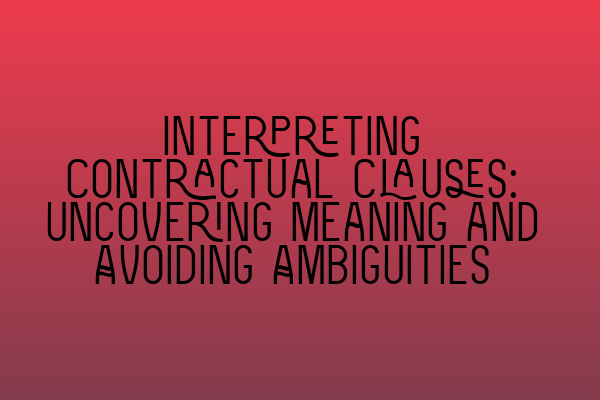Interpreting Contractual Clauses: Uncovering Meaning and Avoiding Ambiguities
Contracts are the foundation of any business relationship. They provide a framework for parties to define their rights, obligations, and expectations. However, interpreting contractual clauses can often be a complex and challenging task. Ambiguities in contract language can lead to disputes and legal complications. Therefore, it is crucial for solicitors and professionals in contract law to have a clear understanding of how to interpret contractual clauses to uncover their true meaning and avoid potential ambiguities.
The Importance of Clear and Precise Language
Before delving into the art of interpreting contractual clauses, it is essential to emphasize the importance of clear and precise language in contracts. The language used in contracts should be unambiguous and leave no room for multiple interpretations. When drafting a contract, solicitors should strive to use simple and plain language that is easily understood by all parties involved.
By using clear and concise language, solicitors can minimize the risk of disputes arising due to misunderstandings or differing interpretations. Clarity in contractual clauses not only protects the rights and interests of the parties involved but also ensures the overall integrity of the contract.
Interpreting Contractual Clauses: Key Principles
When faced with contractual clauses that may be open to interpretation, there are some key principles that solicitors can apply to uncover their true meaning and avoid potential ambiguities:
- The Objective Principle: The objective of contract interpretation is to give effect to the intentions of the parties involved. When interpreting a contract, solicitors should focus on the objective intentions of the parties at the time of entering into the contract. This involves analyzing the language used in the contract and considering the surrounding circumstances and context.
- The Plain Meaning Rule: The plain meaning rule states that the words in a contract should be given their ordinary and plain meaning, unless there is evidence to suggest otherwise. This principle ensures that parties can rely on the ordinary meaning of the words used in the contract and avoids the need for subjective interpretations.
- The Ejusdem Generis Rule: The ejusdem generis rule applies when a general term follows a list of specific terms. In such cases, the general term is interpreted to include only items of the same type or nature as the specific terms listed. This rule helps to avoid ambiguity by narrowing the scope of the general term.
- The Doctrine of Contra Proferentem: The doctrine of contra proferentem states that any ambiguities or uncertainties in a contract should be interpreted against the party that drafted the contract. This principle places the responsibility on the drafter to ensure clarity and precision in the language used.
By applying these key principles, solicitors can navigate through the complexities of contractual clauses and uncover their true intentions.
Tools and Techniques for Interpretation
In addition to these key principles, solicitors can utilize various tools and techniques to aid in the interpretation of contractual clauses:
- Contextual Analysis: Analyzing the surrounding circumstances and context in which the contract was made can provide valuable insights into the intentions of the parties. This may include considering the purpose of the contract, the relationship between the parties, and any relevant industry practices or standards.
- Statutory Interpretation: Contracts may be subject to specific statutory provisions or regulations, which can impact their interpretation. Solicitors should be familiar with the relevant laws and statutes that may influence the interpretation of contractual clauses.
- Usage and Trade Customs: In certain industries or trades, there may be well-established customs or usages that can affect the interpretation of contractual clauses. Solicitors should be aware of any industry-specific customs or practices that may apply.
- Documentary Evidence: When faced with ambiguity, solicitors can consider other relevant documents, such as prior drafts, correspondence, or contemporaneous agreements, to shed light on the intended meaning of the contractual clauses.
- Expert Witnesses: In complex cases where the interpretation of contractual clauses is disputed, solicitors may seek the assistance of expert witnesses who possess specialized knowledge or expertise in the relevant field.
By utilizing these tools and techniques, solicitors can effectively interpret contractual clauses and minimize any potential ambiguities or uncertainties.
Conclusion
Interpreting contractual clauses is a critical skill for solicitors and professionals in contract law. By following key principles such as the objective principle and the plain meaning rule, and utilizing tools and techniques such as contextual analysis and statutory interpretation, solicitors can navigate through the complexities of contractual language and uncover the true intentions of the parties involved.
Clear and precise language is essential in contracts to avoid ambiguities and disputes. By incorporating these principles and techniques into contract drafting and interpretation, solicitors can ensure that contracts accurately reflect the intentions of the parties and provide a solid foundation for business relationships.
To further enhance your understanding of contract law and prepare for the SQE exams, check out these related articles:
